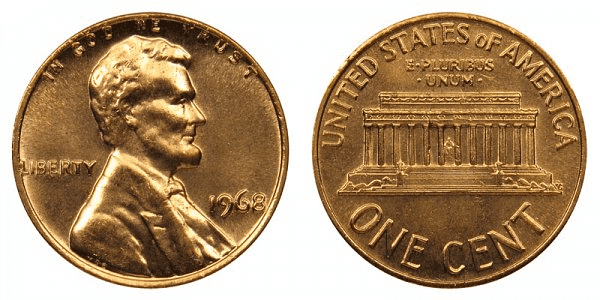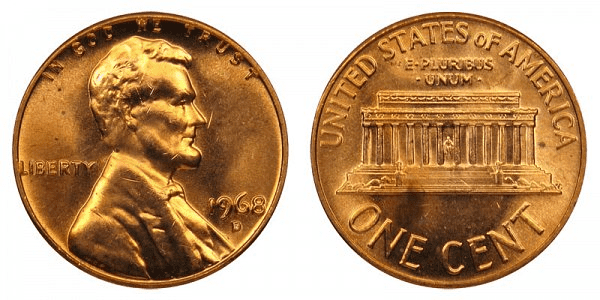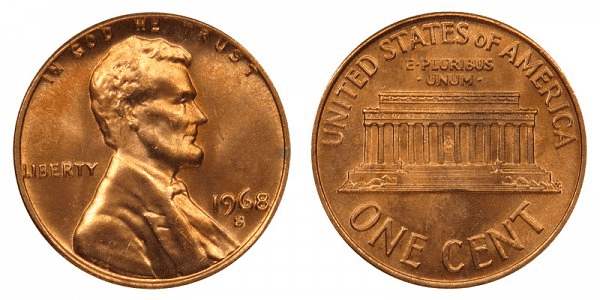What Is Special About A 1968 Penny?
Due to the use of a 50-year-old hub that was worn out, the 1968 cents are considered some of the worst coins ever produced. When the Mint switched to new hubs in 1969, the Lincoln cent once again assumed its intended sculptural elegance.
The 1968 Lincoln cent’s obverse design, which Victor David Brenner developed to celebrate 100 years since Lincoln’s birth, is almost identical from when the type was initially minted in 1909.
The main difference between the 1968 obverse and the 1909 edition is Brenner’s initials, V.D.B., which were transferred from the reverse in late 1909 and added under President Abraham Lincoln’s bust in 1918.
1968 is seen to Lincoln’s right, and the words “IN GOD WE TRUST” are displayed above the president. To the left of the sixteenth president is the word LIBERTY.
Frank Gasparro designed the 1959 Lincoln Memorial reverse, which replaced the 1909 Brenner wheat stalk design, and it can be seen on the 1968 cent. You may find Gasparro’s initials, FG, on the lower right side of the Lincoln Memorial.
The title UNITED STATES OF AMERICA is inscribed around the top portion of the reverse along the rim, with the phrase ONE CENT written below the building and around the rim.
Between the words UNITED STATES OF AMERICA and the top of the Lincoln Memorial is written the motto E PLURIBUS UNUM. The edge of the Lincoln cent is plain or smooth with no reeding or lettering.
Until 1982, when a copper-plated zinc composition was introduced, the Lincoln Cent was comprised of a mixture of bronze and nickel.
1968 saw the first flight of Boeing’s 747 jumbo jet while NASA’s Apollo 8 was in lunar orbit. Two peace campaigners, Martin Luther King Jr. and Robert F. Kennedy, were killed along with the Navy intelligence ship USS Pueblo being sank.
1968 Penny Varieties
1968 Penny With No Mint Mark
Year: 1968
Face Value: $0.01
Composition: 95% copper, 5% zinc
Total Weight: 3.11 grams (or over)
Diameter: 0.750 in. 19.05 mm
Thickness: 0.0598 inches (1.52 mm)
Edge: Plain
Minted in: Philadelphia
Quantity Minted: 1,707,880,970

photo source: www.usacoinbook.com
1968 D Penny
Year: 1968
Face Value: $0.01
Composition: 95% copper, 5% zinc
Total Weight: 3.11 grams (or over)
Diameter: 0.750 in. 19.05 mm
Thickness: 0.0598 inches (1.52 mm)
Edge: Plain
Minted in: Denver
Quantity Minted: 2,886,269,600

photo source: www.usacoinbook.com
1968 S Penny
Year: 1968
Face Value: $0.01
Composition: 95% copper, 5% zinc
Total Weight: 3.11 grams (or over)
Diameter: 0.750 in. 19.05 mm
Thickness: 0.0598 inches (1.52 mm)
Edge: Plain
Minted in: San Francisco
Quantity Minted: 261,311,510

photo source: www.usacoinbook.com
List of errors
As mentioned, 1968 was a very poor year in regards for mint quality. Because of this, there are plenty of well-known 1968 cent error coins, such as those listed below:
- Doubled Die: This expensive penny error is a rare and valuable item. There are still some more uncommon 1968 doubled die pennies that are worth money, even though they are not as valuable as the doubled die pennies from 1955, 1969, or 1972 at the moment. The 1968 penny’s writing, as well as specifics like Lincoln’s eye, beard, ear, and bowtie, should catch your attention because those are the spots where collectors typically detect traces of doubling. According to the degree of the doubling, the value of several of the 1968 doubled die penny types ranges from $25 to $100.
- Repunched Mintmark: In the late 1960s, U.S. Mint coiners hand-punched mintmarks one at a time onto each functioning die, and this human factor inevitably resulted in a few faults and variants concerning the mintmark. Many coin collectors seek out the reasonably frequent repunched mintmark variations. Depending on the size of the mintmark aberration and the quality of the coin, a 1968-D or 1968-S repunched mintmark variant often sells for between $5 and $15.
- Die Breaks: Die Breaks are one method a die can demonstrate wear and tear; this results in cracks on the die in question and raised lines, squiggles, lumps, and bumps on the coin they strike. Die breaks and die cracks are shocking errors, and the values can vary greatly depending on the kind, size, and position of the die fracture. The so-called “BIE” variant of die breaks, which appears as a brief vertical die break between the letters “B” and “E” in the word “LIBERTY” on the obverse, is one of the most prevalent forms on a Lincoln cent. Many BIE pennies are valued between $5 and $10 each.
- Floating Roof: Many coin collectors have noticed pennies depicting what appears to be the top of the Lincoln Memorial roof floating above the rest of this famous Washington, D.C. landmark. The upper-central areas of the coin’s reverse (tail’s side) were overly polished by the die, which is most likely what created the floating roof impression. The floating roof anomaly may appear on any Lincoln Memorial cent struck between 1959 and 2008, but it seems to be more frequent on Lincoln pennies from the late 1960s. The majority of floating roof Lincoln pennies trade between $1 and $5. It’s interesting that not many coin collecting authorities have yet acknowledged floating roof pennies as a form of die variant.
Are There Any Rare 1968 Pennies?
As mentioned, the most sought-after form of the 1968 Penny is the penny with the double-die error which can reach up to $100 dollars in value; pretty impressive considering the coin only has a face value of 1 cent. However, another type of Lincoln Penny that is quite the rarity is the coins in MS or ‘Mint State’ preservation.
As we learned earlier, 1968 was a pretty diabolical year for minting pennies, so finding pennies with a perfect mint is quite the challenge. Overall though, 1968 pennies aren’t the rarest coins out there, they just have a few varieties which are worth looking out for.
How Much Is A 1968 Penny Worth Today?
In circulating conditions, the majority of 1968 pennies are only worth their weight in copper. A penny is currently worth roughly $0.02 when it comes to copper melt value. The only condition in which these coins can be sold for a premium is uncirculated. In uncirculated form with a grade of MS-63RB, the 1968 penny without a mint mark is worth about $0.25.
How Does The Grading System Work?
The Sheldon Scale is used by numismatists to provide a numerical value to coins. The Sheldon Scale goes from poor (P-1) to perfect mint state (P-1) (MS-70). Coins were originally evaluated using words to reflect their condition (Good, Fair, Excellent, Etc.). Unfortunately, coin collectors and dealers had different ideas about what each of these terms represent.
Professional numismatists joined together in the 1970s and established CoinGrading standards. These numismatists now assign grades at key places on the seventy-point scale, using the most regularly utilized numeric points in conjunction with the original adjective grade. The following are the most common coin grades:
-
-
- (P-1) Poor – Indistinguishable and probably damaged; if used, must have a date and mintmark; otherwise, rather battered.
- (FR-2) Fair – Nearly smooth, but without the damage that a coin graded Poor often possesses. The coin must have enough detail to be identified.
- (G-4) Fair – Inscriptions have merged into the rims in some areas, and important elements have been mostly erased.
- (VG-8) Very Good- A little weathered, but all of the primary design elements are visible, albeit faintly. There is little if any, central detail left.
- (F-12) Good – The item is very worn, yet the wear is even, and the overall design details stand out clearly. Rims are almost completely isolated from the field.
- (VF-20) Very Fine – Moderately weathered, with some finer features still visible. The motto or all letters of LIBERTY are readable. Both sides of the coin have entire rims that are separated from the field.
- (EF-40) Extremely Fine – Gently used; all gadgets are visible, and the most important ones are bold. The finer details are bold and clear, however, light wear may be seen.
- (AU-50) Uncirculated – Slight evidence of wear on the coin’s design’s high points; may have contact marks; eye appeal should be adequate.
- (AU-58) Uncirculated Choice – Slight traces of wear, no severe contact marks, almost full mint shine, and great eye appeal.
- (MS-60) Mint State Basal – Strictly uncirculated; no indication of wear on the coin’s highest points, but an unsightly coin with reduced luster, visible contact marks, hairlines, and other flaws.
- (MS-63) Mint State Acceptable – Uncirculated, but with contact scratches and nicks, little reduced shine, but otherwise appealing appearance. The strike is weak to average.
- (MS-65) Mint State Choice – Uncirculated with great mint shine, very little contact blemishes, and exceptional eye appeal. The strike is unusually severe.
- (MS-68) Mint State Premium Quality – Uncirculated with superb luster, no obvious contact marks to the naked eye, and exceptional eye appeal. The strike is quick and appealing.
- (MS-69) Almost Perfect Mint State – Uncirculated with perfect brilliance, a sharp and appealing strike, and extremely good eye appeal. A near-perfect coin with minor imperfections in the planchet, strike, and contact markings (seen only under 8x magnification).
- (MS-70) Mint State Perfect – Under 8x magnification, there are no tiny imperfections discernible; the strike is crisp, and the coin is perfectly centered on a beautiful planchet. Rarely seen on a coin, this coin is bright and whole, with original luster and exceptional eye appeal.
-
Where To Buy Or Sell 1968 Pennies?
Currency Converters
Lincoln Pennies are still in use, thus they are more likely to be encountered in daily life than other uncommon coins. It can be challenging to sell individual Lincoln Pennies online because the bulk of specimens has a poor value. For this reason, one of the greatest options for selling old coins with little value is to use a currency converter like Foreign Currency and Coin.
Marketplaces Online
Because the bulk of 1968 Lincoln pennies are common and have minimal value, doing business on websites like eBay and Etsy is a fantastic and practical alternative. There are also pre-graded coins available, which might be a great way to start your collection off right.
Estate and used goods sales
Even while coin collecting is regarded as an “older” hobby, there are still many devoted young collectors out there. As a result, estate sales frequently feature the collections of older collectors, and it’s not unusual for buyers to find rare coins that have unintentionally come into the public eye. Pay attention!
Auctioneers, forums, and dealers
Both buyers and sellers can feel confident knowing that the coins for sale have previously been graded. Visit specialised dealers, internet forums like Coin Community, and auction houses for more rare specimens of this Penny.
FAQs
What is the value of a 1968 Canadian penny?
Canadian Pennies from this year have a value pretty similar to their non-special American counterparts and are worth a little more than their mint value.
Why are 1968 pennies worth more than 1967?
1968 pennies are worth more than 1967 pennies because of their well-known errors and generally poor mintage which makes good specimens quite hard to find.
Where is the mint mark on a 1968 penny?
The mint mark on the 1968 penny is found on the obverse side of the coin, directly below the year.
How many pennies were minted in 1968?
A total of 4,855,462,080 1968 pennies were minted during this year.



